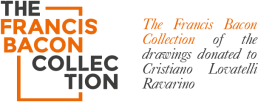29 Mar 2017 – CHURCH TIMES

Crucifixion: one of the Bacon works on display in St Stephen Walbrook, London
FRANCIS BACON (1909-92) was not, in any meaningful sense of the word, a “religious” painter, and he never received any ecclesiastical commission. The famous 1944 triptych of swollen bandaged figures in Three Studies for Figures at the Base of a Crucifixion (Tate) assured his reputation as a Young British Artist. He revisited the subject, and painted a second version of it in a grander style, in 1988.
But neither it nor the series of paintings of a screaming pope, boxed in a cage, that he began in 1949 and which were inspired by the portrait by Velázquez of Innocent X, which he knew only from a postcard, made him a suitable choice for deans to commission.
His background was peripatetic, shuttling between London and Dublin. He had boarded at Dean Close School between 1924 and 1926 (when he was not running away), but largely ignored that school’s professed Evangelical disposition. The Berlin of the Weimar Republic offered a rich storehouse of forbidden pleasures to the 18-year-old Bacon, which, after the puritanism of his upbringing, largely went to his head, and other parts of his anatomy.
His lifestyle and the range of his most frequent subjects could suggest that he was an atheist at heart, but in fact Bacon often professed a longing to find belief in the way that, for example, Titian had manifested. He was deeply respectful of churches (scarcely reciprocated at the time by churchmen) and, although not a believer, he longed to have a belief.
As so often, artists reveal more of themselves in drawings than in other media; the current Lenten hang at St Stephen Walbrook, in the City of London, will come as a shock to those who think that they know their Bacon, and as a surprise to those who want to find a space for their prayer and devotions away from the harsh savagery of the Square Mile.
Ben Moore (FRSA) is no stranger to curating works of art in churches (Arts, 6 March 2015), and has brought together drawings of the Crucified, alongside four pastel and collage depictions of a seated pope, which belong to a private collector, Cristiano Lovatelli Ravarino, from Bologna.
As a young journalist, Ravarino had been befriended by the artist in the 1970s, and has loaned nearly two dozen revelatory works to cover the walls of this Wren church, for which Henry Moore provided the stone altar (itself the subject of a protracted dispute in the ecclesiastical courts).
Nine graphics of the head and shoulders of the Crucified on the cross are ranged along the north wall, and a further nine are placed opposite, of which half a dozen are coloured with pastel. They all were apparently given to Ravarino between 1977 and 1992 — not that they are without notoriety: Ravarino faced a court tribunal in his native Bologna to prove that the drawings were authentic, as the artist had apparently cut off the paper manufacturer’s tell-tale logo, allegedly thinking it was just an advertisement, and may have signed them only later when inebriated. Until a convention was held in Cork Street, London, in February 2012, there had been serious debate about their authenticity, although critics such as Edward Lucie-Smith, David Nahmad, and Vittorio Sgarbi have never had any doubts.
The graphics themselves show Bacon wrestling with the unknown faith that for some lies behind such images. Although the bulbous, anonymous heads may offend some, there is, as the Revd Jonathan Evens, the priest-in-charge, points out, a strong apophatic tradition in Christianity: that which cannot be spoken and that which cannot be revealed in word. Each is drawn as if from above, a vertiginous angle that makes them difficult to hang, and which owes much to the likes of Salvador Dalí.
Either side of the figures of Moses and Aaron and the Ten Commandments on the east wall are four colourful pastels of seated figures, reminiscent of the screaming popes, but less substantial, and somewhat lost behind the paraphernalia of the church’s furnishing.
Ben Moore tells me that reproductions of some of the drawings are being shown by Art Below at selected tube stations in central London, bringing the controversy of the Cross into the public domain.
“Crucifixions: Francis Bacon” is at St Stephen Walbrook, London EC4, until 31 March. Phone 020 7626 9000. https://ststephenwalbrook.net/
